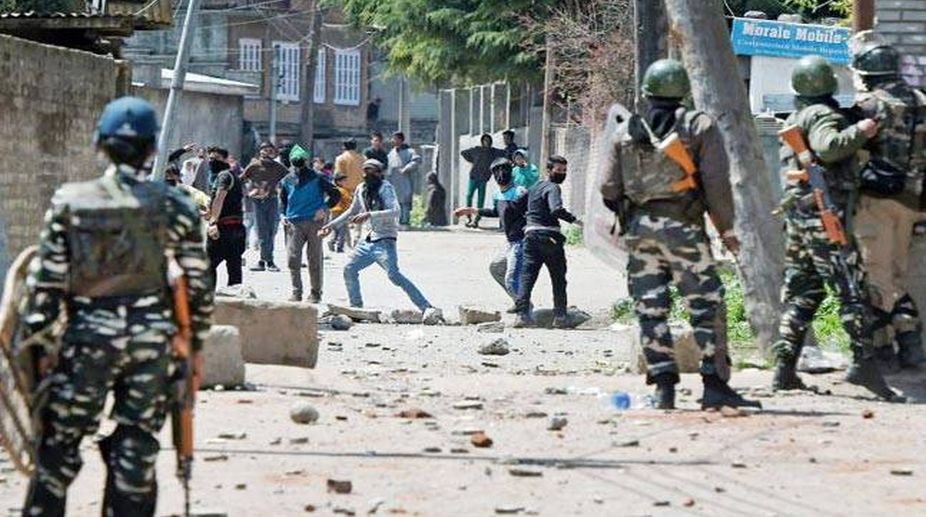Army chief asks Kashmiri youth to shun mindless violence
Army chief General Bipin Rawat on Monday asked the Kashmiri youth to shun the path of mindless violence saying this would not let them live long.

(Photo: Twitter)
The recent bypoll in Srinagar and resultant video footage dominated headlines for all the wrong reasons.
Holding elections in a strife-torn region was a wrong decision to start with. Even the state had protested to the Election Commission (EC).
However, for the EC and the government, it was a tough choice. Delaying the election would have given the opposition including the National Conference (NC) and proPakistan separatists more ammunition.
Advertisement
Poll-eve violence when eight protestors were killed in police firing and scores including police and CRPF personnel injured should have been the trigger to call off the election.
EC failed to read the scenario and act in time, resulting in only seven percent polling. With time this will haunt the government.
A flood of videos began emerging, some showing security personnel containing agitators and some of Central Armed Police Force (CAPF) and police personnel being heckled, manhandled and assaulted by locals.
However, the video which grabbed national headlines, resulting in widespread debate and comments was that of a local, Farooq Ahmed Dar, being tied to the front of a jeep. Most critics of the action termed it as ‘employment of a human shield by the army’.
Amongst the critics were also a few veterans, who opined that this video would haunt the army for ages.
Opposition parties and armchair strategists termed it as shameful for the army, some claiming that the army has become anti-national and lost the goodwill of the locals.
However, within the nation and from all walks of life, the Army also received immense support. Many supported the young major who took this decisive step, ignoring those who had criticised the action.
The hierarchy of the Army and the government took a firm decision to support him. However, possibly to strengthen its stand for any future legal engagement, the Army has ordered a Court of Inquiry (COI) to enquire into the circumstances leading to the incident.
For those who pass judgement in haste and resort to bashing organisations, it is essential to understand the circumstances under which the incident occurred. Many versions are afloat, however for a layman the situation can be easily explained.
It was election day and violence was in the air. Mobs were moving around, targeting polling booths, preventing people from voting and attacking security personnel at random.
As per the Election Commission’s ruling, security to polling booths is to be provided by CAPF and local police.
The Army is only in an area-domination role, to prevent any militant attack.
At one polling booth in Budgam, ITBP and police personnel were surrounded by a violent, threatening mob of over five hundred.
There was a fear that they could be lynched. They appealed to the army for assistance and the army reacted. A Quick Reaction Team (QRT) under a major in the vicinity was tasked to rescue the trapped personnel. Here is where there are differences on what transpired.
Some claim that Farooq Ahmed Dar was picked up while returning from voting, while the army version says that he was one of the stone throwers and hence detained.
Regardless, the situation was grave. The QRT was small and light, the mob large. Under normal circumstances, the trapped personnel of CAPF and police, feeling threatened by the mob, could have opened fire in self-defence, resulting in casualties.
However, ultimately the mob may have prevailed and they would have become casualties, possibly even killed.
The Army officer would have been compelled to break into this mass of violent humanity only by opening fire, thus adding to casualties. Such action would have made headlines across the globe and been seen as highhanded.
This solution employed by the officer on the spur of the moment created such fear amongst those surrounding the booth that they opened a path for him, thus enabling rescue of the trapped staff without a shot being fired.
This ingenious action therefore prevented a catastrophe. The individual was taken back to the military camp, offered a cup of tea and then handed over to his village sarpanch, unharmed and secure.
To make the officer the only culprit was unwarranted. To compare the army to an occupation force was unjustified. If the Army was highhanded, then the mob which surrounded the booth and threatened personnel inside was not made up of saints.
Similarly, those who insulted and attacked CAPF personnel on polling duty were no innocents. In a similar vein, those who pelt stones and interrupt operations against militants intentionally, enhancing army casualties, are no nationalists, nor are they simply misguided youth, as termed by the opposition.
In any jurisdiction, assaulting government staff on duty is a crime, hence must be acted against. Showing restraint, avoiding the use of firing except as a last resort, accepting injuries and insults, security forces have faced the brunt.
Had the political leadership and local intelligentsia sought to wean away youth from the path of selfdestruction, Kashmir would not have been at the crossroads it now is at.
At this juncture, instead of playing politics and indulging in one-upmanship, everyone needs to join hands to defuse the situation, prevent loss of lives and injuries to youth.
The youth are our future, they need to be educated, not turned against the state, misguided and made cannon fodder for Pakistan or their Hurriyat supporters.
The writer is a retired Major-General of the Indian Army.
Advertisement